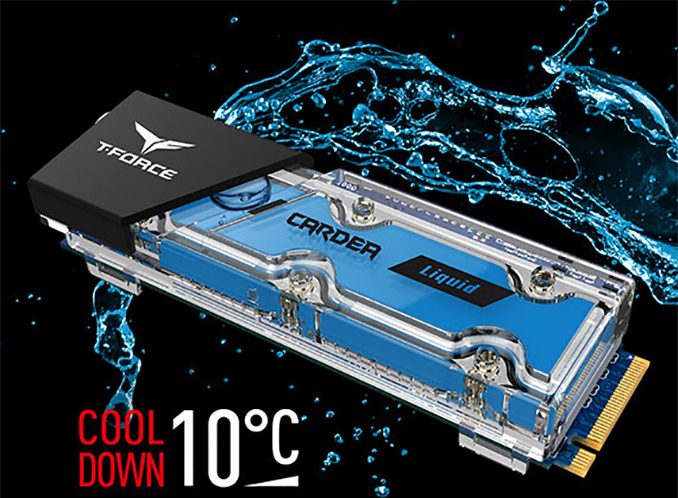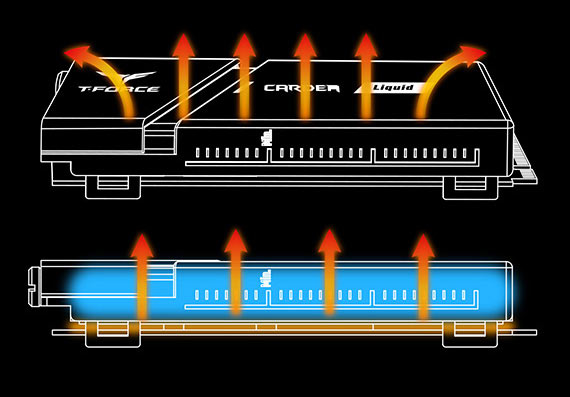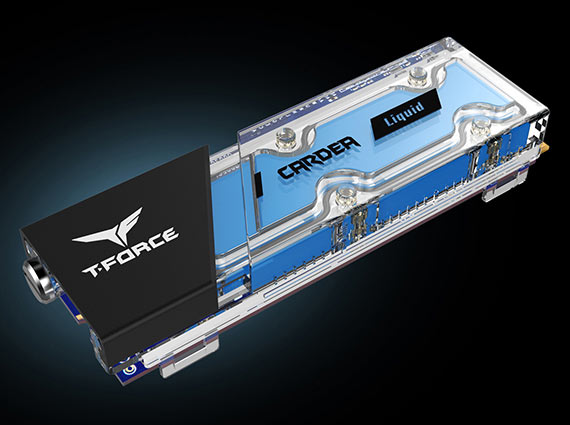Team Group’s T-Force Cardea Liquid: A Liquid-Cooled M.2 SSD
by Anton Shilov on July 26, 2019 1:00 PM EST- Posted in
- SSDs
- Storage
- M.2
- 3D TLC
- Team Group
- PS5012-E12
- T-Force Cardea Liquid

With liquid cooling options already available for most PC components, it was only a matter of time until someone did it for PC storage as well. And now that point has come, thanks to Team Group and its T-Force Cardea Liquid M.2 PCIe Gaming SSD.
True to its name, the T-Force Cardea Liquid M.2 PCIe Gaming SSD is an M.2 SSD relying on water cooling to keep its temperature in check. And while it's not a looped cooling device – despite using liquid cooling, it's still a stand-alone, closed device that doesn't get plugged in to an open loop system – it's none the less a novel step in developing more exotic SSD cooling systems. Using their liquid cooling module, Team Group says that their cooling system will reduce temperature of the drive by 10ºC when compared to a SSD without a heat sink.
The cooling system of the T-Force Cardea Liquid is relatively simple. The liquid cooling module relies on the self-circulation effect by separating the water block into two chambers. When the coolant in the chamber above the controller/memory gets hot, it flows to the second chamber to cool down. Essentially, the aluminum water block acts like a vapor chamber, but uses a mainstream coolant instead of a specialized low boiling point liquid. This kind of cooler is cheap to make, and since it is shipped without any water inside (it's designed to be filled by the end user), there is no risk of leakage during shipping. Because it's still a closed cooling system, the SSD and its cooling module still requires a good airflow inside the PC case to pull heat away and out of the system, but using a liquid to cool down a high-end SSD is certainly an innovative method.
Set to be available in 256 GB, 512 GB, and 1 TB versions, the T-Force Cardea Liquid is compatible with any desktop PC featuring an M.2-2280 slot supporting a PCIe 3.0 x4 interface. With that said, the the drive is far taller than normal SSDs at 14.1 mm high, so one has to make sure there is enough space around it to fit.
The liquid-cooled SSD from Team Group is based on Phison's PS5012-E12 controller as well as 3D TLC NAND from an undisclosed manufacturer. When it comes to performance, the top-of-the-range 1 TB model of the T-Force Cardea Liquid will offer up to 3400 MB/s sequential read speed, up to 3000 MB/s sequential write speed (when pSLC caching works), up to 450K IOPS random read speed, and up to 400K IOPS random write speed. Since this is a consumer SSD, we are talking about peak numbers here.
| Team Group T-Force Cardea Liquid M.2 PCIe SSD Specifications | |||
| Capacity | 256 GB | 512 GB | 1 TB |
| Model Number | TM8FP5256G0C119 | TM8FP5512G0C119 | TM8FP5001T0C119 |
| Controller | Phison PS5012-E12 | ||
| NAND Flash | 3D TLC NAND | ||
| Form-Factor, Interface | M.2-2280, PCIe 3.0 x4, NVMe 1.3 | ||
| Sequential Read | 3000 MB/s | 3400 MB/s | |
| Sequential Write | 1000 MB/s | 2000 MB/s | 3000 MB/s |
| Random Read IOPS | 200K IOPS | 350K IOPS | 450K IOPS |
| Random Write IOPS | 200K IOPS | 300K IOPS | 400K IOPS |
| Pseudo-SLC Caching | Supported | ||
| DRAM Buffer | ? | ||
| TCG Opal Encryption | No | ||
| Power Management | ? | ||
| Warranty | 3 years | ||
| MTBF | 2,000,000 hours | ||
| TBW | >380 TB | >800 TB | >1665 TB |
| Additional Information | Link | ||
| MSRP | ? | $100.99 | $169.99 |
Team Group will start selling its T-Force Cardea Liquid drives in the near future. Pricing is something that remains to be seen, but keep in mind that this is a high-end SSD family.
Related Reading:
- Alphacool Releases Two New SSD Coolers: Passive HDX-2 and Watercooled HDX-3
- The Team Group MP34 512GB SSD Review: Refining Phison's NVMe Workhorse
- ADATA Announces XPG Storm: A Cooler for M.2 SSDs with a 16500 RPM Fan
- CES 2019: TeamGroup And ASRock Release Phantom Gaming Branded Memory and SSD
- EKWB Launches Aftermarket EK-M.2 Aluminum Heatsink for M.2 SSDs
Source: Team Group













34 Comments
View All Comments
Ryan Smith - Friday, July 26, 2019 - link
You are correct, sir!Scott_T - Friday, July 26, 2019 - link
I seem to recall that the nand memory used in those prefers to be on the warm side for proper functioning. controller needs to be cool though like any cpu.Ashinjuka - Friday, July 26, 2019 - link
I eagerly await the McDLT NVMe TLC SSD.LtGoonRush - Monday, July 29, 2019 - link
Yeah an optimal heat spreader arrangement thermally connects the controller and NAND together, cooling the controller and warming the NAND.ballsystemlord - Saturday, July 27, 2019 - link
The images of the drive do not depict any fins for heat dissipation and the entire water chamber appears to be enclosed in plastic, so how does the head get out exactly?lopri - Saturday, July 27, 2019 - link
Yah. I think this will heat up the chips more, not less. Plastic is going to insulate heat.ozzuneoj86 - Sunday, July 28, 2019 - link
I... don't even..."... and since it is shipped without any water inside (it's designed to be filled by the end user), there is no risk of leakage during shipping."
If leakage during shipping is even a remote possibility, why on EARTH would anyone want to put water in one of these and then mount it in their expensive PC? Many times, it will end up directly above what is probably the most expensive component in the system (the GPU).
Water shouldn't come out of this, no matter what it goes through in shipping. If they don't trust the seals on their "water coolers" no one should.
Also, imagine how much fun it probably is getting Squad Bunch, I mean Team Group, to replace one of these if it fails. "You put water in it? You may have spilled some or reassembled it incorrectly. Warranty void." "You didn't put water in it? Improper cooling. Warranty void."
Rοb - Sunday, July 28, 2019 - link
A Lava Lamp or Bubble Light would be so much cooler.drexnx - Monday, July 29, 2019 - link
now THIS is a good ideaGunbuster - Monday, July 29, 2019 - link
Heat enters via the metal heat plate and transfers to a paltry amount of water that in entirely ensconced/insulated with plastic over the entire possible side and upper radiative surface area. SMH